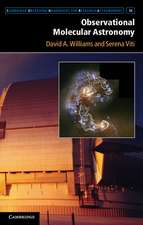Seeing Stars: The Night Sky Through Small Telescopes: The Patrick Moore Practical Astronomy Series
Autor C. R. Kitchin, Robert W. Forresten Limba Engleză Hardback – 17 noi 1997
| Toate formatele și edițiile | Preț | Express |
|---|---|---|
| Paperback (1) | 385.84 lei 6-8 săpt. | |
| SPRINGER LONDON – 5 oct 2012 | 385.84 lei 6-8 săpt. | |
| Hardback (1) | 645.47 lei 6-8 săpt. | |
| SPRINGER LONDON – 17 noi 1997 | 645.47 lei 6-8 săpt. |
Din seria The Patrick Moore Practical Astronomy Series
-
 Preț: 258.21 lei
Preț: 258.21 lei -
 Preț: 164.94 lei
Preț: 164.94 lei -
 Preț: 298.91 lei
Preț: 298.91 lei -
 Preț: 255.10 lei
Preț: 255.10 lei - 8%
 Preț: 581.98 lei
Preț: 581.98 lei -
 Preț: 159.16 lei
Preț: 159.16 lei -
 Preț: 282.38 lei
Preț: 282.38 lei -
 Preț: 308.55 lei
Preț: 308.55 lei -
 Preț: 309.87 lei
Preț: 309.87 lei -
 Preț: 332.98 lei
Preț: 332.98 lei -
 Preț: 251.60 lei
Preț: 251.60 lei -
 Preț: 243.94 lei
Preț: 243.94 lei -
 Preț: 183.40 lei
Preț: 183.40 lei -
 Preț: 378.09 lei
Preț: 378.09 lei -
 Preț: 302.20 lei
Preț: 302.20 lei -
 Preț: 210.01 lei
Preț: 210.01 lei -
 Preț: 212.68 lei
Preț: 212.68 lei -
 Preț: 271.39 lei
Preț: 271.39 lei -
 Preț: 252.91 lei
Preț: 252.91 lei -
 Preț: 256.64 lei
Preț: 256.64 lei -
 Preț: 264.56 lei
Preț: 264.56 lei -
 Preț: 218.84 lei
Preț: 218.84 lei -
 Preț: 257.08 lei
Preț: 257.08 lei -
 Preț: 128.86 lei
Preț: 128.86 lei -
 Preț: 301.10 lei
Preț: 301.10 lei -
 Preț: 204.78 lei
Preț: 204.78 lei -
 Preț: 307.44 lei
Preț: 307.44 lei -
 Preț: 303.07 lei
Preț: 303.07 lei -
 Preț: 258.83 lei
Preț: 258.83 lei -
 Preț: 155.25 lei
Preț: 155.25 lei -
 Preț: 193.97 lei
Preț: 193.97 lei -
 Preț: 208.26 lei
Preț: 208.26 lei -
 Preț: 279.09 lei
Preț: 279.09 lei -
 Preț: 303.51 lei
Preț: 303.51 lei -
 Preț: 252.24 lei
Preț: 252.24 lei -
 Preț: 208.51 lei
Preț: 208.51 lei -
 Preț: 214.86 lei
Preț: 214.86 lei -
 Preț: 304.58 lei
Preț: 304.58 lei -
 Preț: 220.57 lei
Preț: 220.57 lei -
 Preț: 157.32 lei
Preț: 157.32 lei -
 Preț: 250.68 lei
Preț: 250.68 lei -
 Preț: 288.98 lei
Preț: 288.98 lei -
 Preț: 261.49 lei
Preț: 261.49 lei -
 Preț: 279.09 lei
Preț: 279.09 lei -
 Preț: 160.82 lei
Preț: 160.82 lei -
 Preț: 301.72 lei
Preț: 301.72 lei -
 Preț: 254.90 lei
Preț: 254.90 lei -
 Preț: 304.38 lei
Preț: 304.38 lei -
 Preț: 256.84 lei
Preț: 256.84 lei
Preț: 645.47 lei
Preț vechi: 759.37 lei
-15% Nou
Puncte Express: 968
Preț estimativ în valută:
123.52€ • 128.23$ • 102.100£
123.52€ • 128.23$ • 102.100£
Carte tipărită la comandă
Livrare economică 24 martie-07 aprilie
Preluare comenzi: 021 569.72.76
Specificații
ISBN-13: 9783540760306
ISBN-10: 354076030X
Pagini: 204
Ilustrații: XIII, 186 p.
Dimensiuni: 178 x 254 x 15 mm
Greutate: 0.56 kg
Ediția:1998
Editura: SPRINGER LONDON
Colecția Springer
Seria The Patrick Moore Practical Astronomy Series
Locul publicării:London, United Kingdom
ISBN-10: 354076030X
Pagini: 204
Ilustrații: XIII, 186 p.
Dimensiuni: 178 x 254 x 15 mm
Greutate: 0.56 kg
Ediția:1998
Editura: SPRINGER LONDON
Colecția Springer
Seria The Patrick Moore Practical Astronomy Series
Locul publicării:London, United Kingdom
Public țintă
Popular/generalCuprins
1 Finding Your Way Around the Sky.- 1.1 Introduction.- 1.2 Constellations.- 1.3 Star Hopping.- 1.4 Positions in the Sky.- 1.5 Star Charts and Other Helpful Items.- 2 Your Telescope and How to get the Best Out of It.- 2.1 Telescope Designs.- 2.2 Eyepieces.- 2.3 Collimation.- 2.4 Mountings.- 2.5 Optics.- 2.6 Cleaning and Aluminising.- 2.7 Dewing-up.- 2.8 Observing Techniques.- 2.9 Twinkling.- 2.10 Finder Charts.- 2.11 Keeping a Log Book.- 2.12 Discoveries.- 3 The Sun.- 3.1 Warning.- 3.2 Observing the Sun.- 3.3 Solar Observing Programmes.- 3.4 More Advanced Work.- 4 The Moon.- 4.1 Introduction.- 4.2 Naked-eye Work and Binoculars.- 4.3 The Moon through the Telescope.- 4.4 An Optimum Telescope for Lunar Work.- 4.5 More Advanced Investigations.- 5 The Planets and Minor Solar System Objects.- 5.1 Introduction.- 5.2 Mercury, Venus, Mars, Jupiter and Saturn.- 5.3 Uranus, Neptune, Pluto and the Asteroids.- 6 Comets.- 6.1 Introduction.- 6.2 Cometary Orbits.- 6.3 The Structure of Comets.- 6.4 Origins.- 6.5 Famous Comets.- 6.6 Nomenclature of Comets.- 6.7 Observing Comets.- 7 Stars.- 7.1 Introduction.- 7.2 Brightness.- 7.3 Variable Stars.- 7.4 Visual Double and Binary Stars.- 7.5 Star Clusters.- 8 Nebulae.- 8.1 Introduction.- 8.2 Gas and Dust Clouds.- 8.3 Dark Nebulae.- 8.4 Reflection Nebulae.- 8.5 Emission Nebulae.- 8.6 Supernova Remnants.- 8.7 Planetary Nebulae.- 9 Galaxies.- 9.1 Introduction.- 9.2 Spiral Galaxies.- 9.3 Elliptical Galaxies.- 9.4 Irregular Galaxies.- 9.5 Quasars, Seyfert Galaxies and Other Active Galaxies.- 10 Unaided Observations.- 10.1 Introduction.- 10.2 The Moon.- 10.3 The Sun.- 10.4 Meteors.- 10.5 The Milky Way, the Zodiacal Light and Aurorae.- 10.6 Comets and Planets.- 10.7 Spacecraft.- 10.8 UFOs.- 11 Advanced Work.- 11.1 Introduction.- 11.2 Nebular and Light-pollution Filters.- 11.3 Colour Filters.- 11.4 Photography with Your Telescope.- 11.5 CCDs.- 11.6 Photometry.- 11.7 Occultations.- 11.8 Computers in Astronomy.- 11.9 Spectroscopy.- Appendix 1: Astronomical Societies.- Appendix 2: Bibliography.- Appendix 3: Messier and Caldwell Catalogues.- Appendix 4: A Selection of Choice Astronomical Objects for Viewing.- Appendix 5: The Greek Alphabet.- Appendix 6: Constellations.- Appendix 7: Useful World-Wide-Web and Internet Addresses.- Appendix 8: Terminology.
Caracteristici
Photographs on many interesting and astronomical objects and starfields are photographed to show how they would look through different sizes of amateur telescope, providing the reader with a reference against which to judge the effectiveness of his own equipment and observing techniques. Photographs also show the severe effects of light-polluted skies, and illustrate major constellations as seen from a range of observing sites. This is of great help to the observer, particularly the newcomer who may find it hard to locate specific stars in the night sky.
















